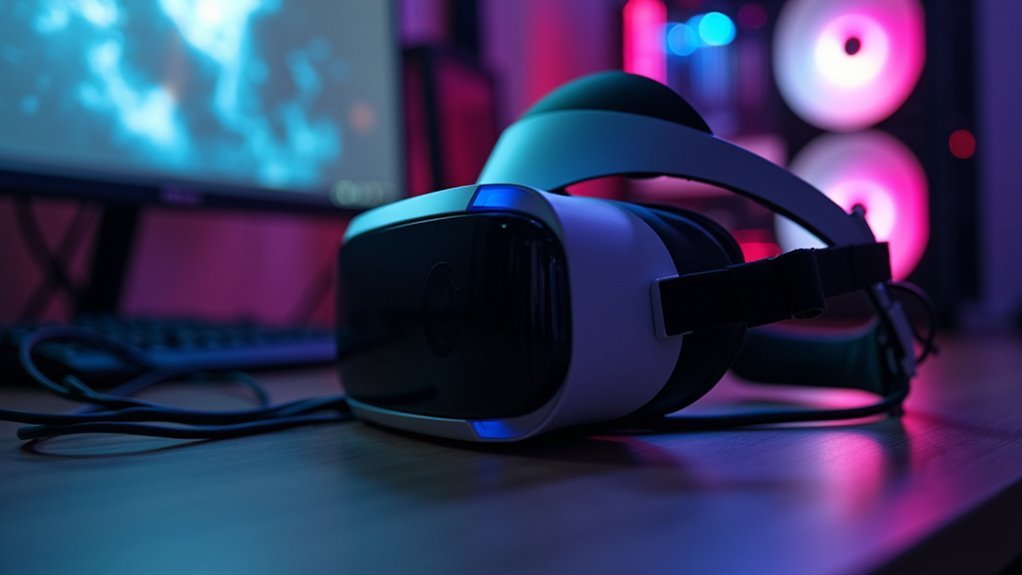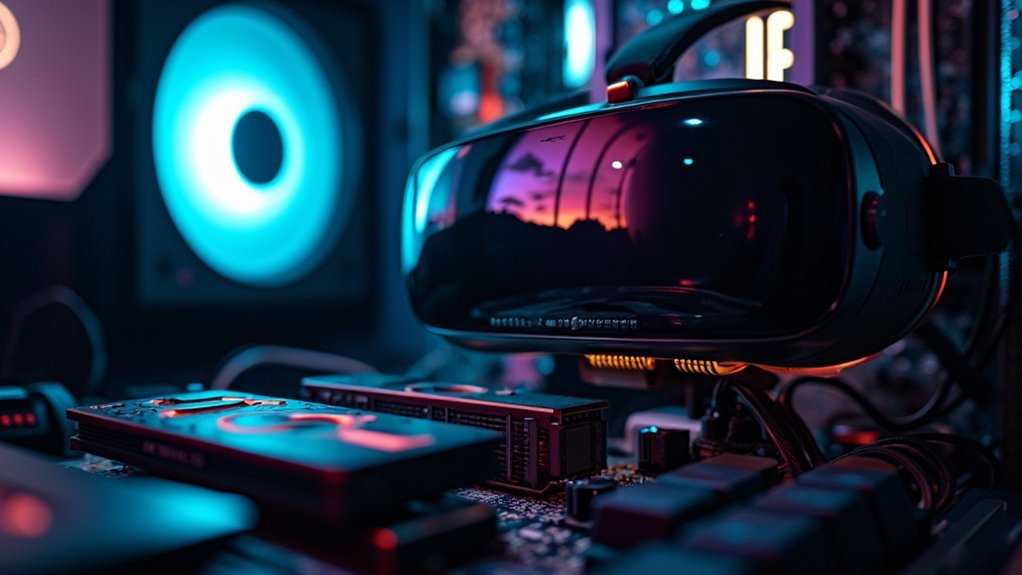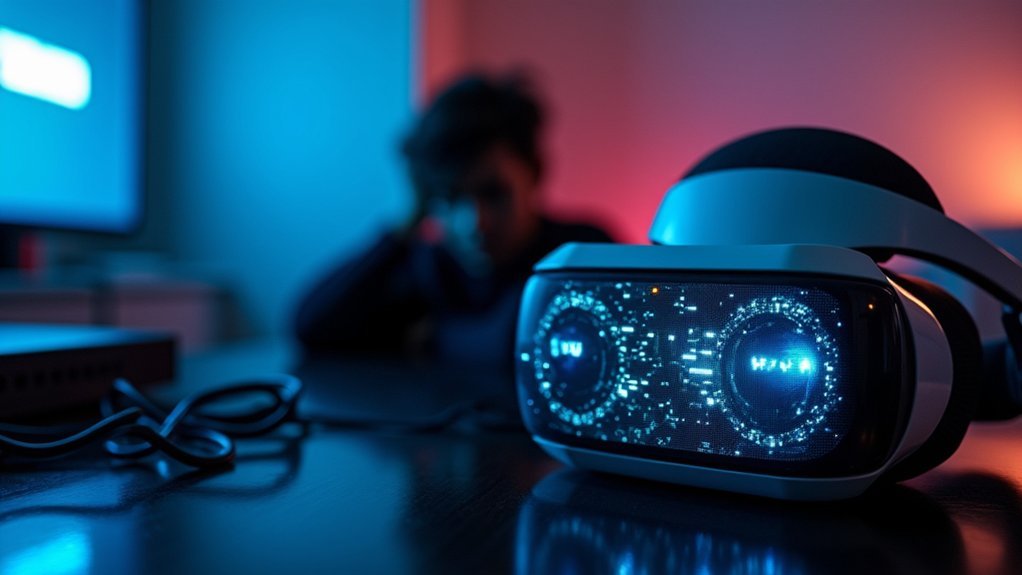Your VR experience lags because your hardware can’t meet VR’s demanding requirements. You need a high-end GPU like the RTX 3080ti, at least 32GB of RAM, and a powerful CPU like the Ryzen 7 5800X. Software issues also cause problems—running games through SteamVR instead of native platforms creates overhead, while background applications steal resources. Poor network connections, tracking malfunctions, and inadequate cooling further degrade performance. Understanding these specific causes will help you optimize your setup.
Hardware Bottlenecks That Impact VR Performance

When your VR experience stutters or drops frames, hardware bottlenecks are often the culprit behind these frustrating performance issues.
Your GPU bears the heaviest load, with powerful cards like the Radeon RX 6950 XT or RTX 3080ti maintaining smooth frame rates even at demanding graphics settings.
High-end GPUs like the RX 6950 XT and RTX 3080ti deliver the raw processing power essential for stutter-free VR gaming.
Insufficient RAM below 32GB causes stuttering since VR applications consume significant memory.
Your CPU’s processing power matters too—a Ryzen 7 5800X outperforms older processors struggling with VR workloads.
An SSD like the Samsung 980 dramatically reduces load times compared to traditional drives.
Poor ventilation creates overheating that throttles performance, while hardware and software optimization guarantees your system delivers the immersive experience VR promises.
Software Configuration Issues Causing Frame Drops
Even with powerful hardware in place, software configuration mistakes can sabotage your VR performance and create jarring frame drops that break immersion.
Your software settings directly impact how smoothly VR applications run. Here are three critical configuration issues that’ll tank your performance:
- Running VR games through SteamVR instead of native Oculus – This creates unnecessary processing overhead that kills frame rates.
- Enabling Hardware-Accelerated GPU Scheduling (HAGS) – While meant to boost performance, it often causes stuttering and lag in VR.
- Leaving background applications running – These consume precious CPU and GPU resources your headset needs.
Additionally, poorly optimized graphics settings like high shadow quality sacrifice visual fidelity for performance.
Always update firmware and install bug fixes to maintain a stable connection between your headset and PC.
Network and Connection Problems in Wireless VR

While software misconfigurations can wreak havoc on your VR performance, wireless connection issues present an entirely different set of challenges that’ll make your virtual world stutter and lag.
Your wireless VR headset depends on a robust Wi-Fi network, preferably 5GHz, to maintain smooth gameplay. Signal interference from competing devices or physical obstacles between your headset and router creates devastating latency spikes.
Signal interference and physical obstacles between your VR headset and router create devastating latency spikes that ruin immersion.
Network congestion during peak hours compounds these problems, causing inconsistent frame delivery. You can improve connection stability by updating your router firmware regularly, which enhances data transmission speeds.
However, when reliability matters most, tethered setups with high-quality cables remain your best defense against unpredictable wireless performance issues.
Tracking System Malfunctions and Sensor Interference
Although wireless connectivity creates its share of problems, tracking system malfunctions and sensor interference can instantly destroy your VR immersion through jarring stutters and responsiveness failures.
Your tracking system’s accuracy depends heavily on proper sensor placement and environmental conditions. When sensors can’t maintain clear sight lines or detect sufficient visual features, you’ll experience significant latency and performance degradation.
Critical factors affecting your VR experience:
- Sensor obstruction – Blocked sensors cause immediate tracking failures and responsiveness loss
- Poor calibration – Miscalibrated sensors create drift that compromises tracking accuracy over time
- Inadequate lighting or visual features – Inside-out tracking systems need distinct environmental markers to function properly
Regular calibration maintenance and ensuring unobstructed sensor positioning are essential for consistent performance.
Without proper sensor management, even minor interference will translate into noticeable lag during head movements and controller interactions.
GPU and CPU Optimization Strategies for Smooth Gameplay

Your system’s processing power directly determines whether you’ll enjoy smooth VR gameplay or suffer through frustrating lag spikes. Upgrading to high-performance components like the AMD Radeon RX 6950 XT or Nvidia RTX 3080ti GPU dramatically improves graphics processing, delivering smoother frame rates in virtual reality.
Pairing these with a powerful CPU like the Ryzen 7 5800X guarantees efficient processing and reduced lag.
You’ll need at least 32GB of RAM to handle demanding VR games without stuttering. Optimize performance by adjusting settings – lower resolution, disable demanding visual effects, and reduce shadow quality to lighten your GPU and CPU workload.
Installing games on SSDs decreases load times and reduces latency. These optimization strategies transform choppy virtual reality experiences into seamless, immersive gameplay sessions.
Frequently Asked Questions
How Do I Reduce Lag in VR?
You’ll reduce VR lag by lowering resolution settings, closing background apps, using wired connections, updating firmware regularly, and optimizing graphics options like shadows and motion smoothing for better performance.
Why Is My Virtual Desktop Suddenly so Laggy?
Your virtual desktop’s sudden lag likely stems from wireless interference, background apps consuming resources, outdated drivers, or changed network conditions. Check your router’s 5GHz connection and close unnecessary programs immediately.
Why Are VR Videos so Laggy?
VR videos lag because you’re pushing your hardware too hard. Your GPU can’t handle high-resolution rendering, your VRAM’s maxed out, or you’ve got connection issues affecting smooth playback performance.
Why Is My VR so Glitchy?
Your VR’s glitchy because you’ve got hardware limitations, outdated drivers, or poor connection quality. Complex content strains your system’s resources, causing stuttering and visual artifacts that’ll ruin your immersive experience completely.





Leave a Reply